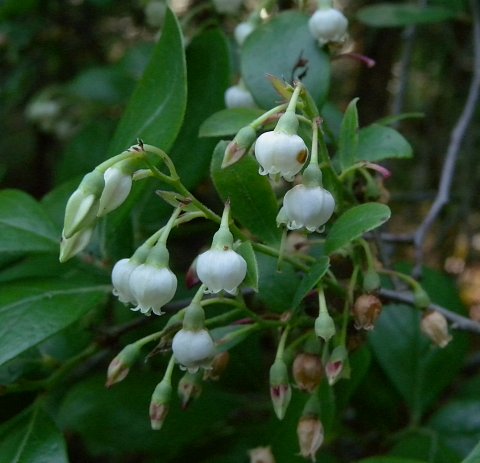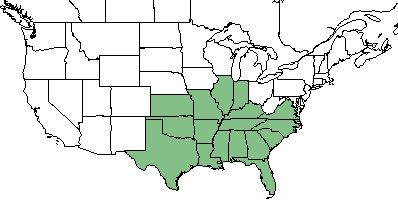Difference between revisions of "Vaccinium arboreum"
(→Ecology) |
|||
| Line 1: | Line 1: | ||
{{italic title}} | {{italic title}} | ||
| + | Common names: farkleberry<ref name= "USDA"> [https://plants.usda.gov/core/profile?symbol=CEAM USDA Plant Database]</ref>, sparkleberry <ref name="behm">Behm, A. L., et al. (2004). "Flammability of native understory species in pine flatwood and hardwood hammock ecosystems and implications for the wildland-urban interface." International Journal of Wildland Fire 13: 355-365.</ref>, winter huckleberry <ref name="blair">Blair, R. M. (1971). "Forage production after hardwood control in a southern pine-hardwood stand." Forest Science 17(3): 279-284.</ref>, tree sparkleberry <ref name= "bowman">Bowman, J. L., et al. (1999). Effects of red-cockaded woodpecker management on vegetative composition and structure and subsequent impacts on game species. Proceedings of the Fifty-third Annual Conference, Southeastern Association of Fish and Wildlife Agencies. A. G. Wong, P. Doerr, D. Woodward, P. Mazik and R. Lequire. Greensboro, NC, Southeastern Association of Fish and Wildlife Agencies: 220-234.</ref>, tree huckleberry <ref name=";ay">Lay, D. W. (1956). "Effects of prescribed burning on forage and mast production in southern pine forests." Journal of Forestry 29(9): 582-584.</ref> | ||
<!-- Get the taxonomy information from the NRCS Plants database --> | <!-- Get the taxonomy information from the NRCS Plants database --> | ||
{{taxobox | {{taxobox | ||
| Line 48: | Line 49: | ||
''V. arboreum'' has a medium tolerance of fire. <ref name= "USDA"> [https://plants.usda.gov/core/profile?symbol=CEAM USDA Plant Database]</ref> | ''V. arboreum'' has a medium tolerance of fire. <ref name= "USDA"> [https://plants.usda.gov/core/profile?symbol=CEAM USDA Plant Database]</ref> | ||
| − | Given ''V. arboreum'' is usually maintained by fire. <ref name= "Weakley"> Weakley, A. S. (2015). Flora of the Southern and Mid-Atlantic States. Chapel Hill, NC, University of North Carolina Herbarium.</ref> | + | Given ''V. arboreum'' is usually maintained by fire, when the habitat is fire suppressed the species will grow to maturity and taller than in fire maintained regions. <ref name= "Weakley"> Weakley, A. S. (2015). Flora of the Southern and Mid-Atlantic States. Chapel Hill, NC, University of North Carolina Herbarium.</ref> <ref name="rodger">Rodgers, H. L. and L. Provencher (1999). "Analysis of Longleaf Pine Sandhill Vegetation in Northwest Florida." Castanea 64(2): 138-162.</ref> |
<!--Fire tolerance, fire dependence, adaptive fire responses--> | <!--Fire tolerance, fire dependence, adaptive fire responses--> | ||
<!--===Pollination===--> | <!--===Pollination===--> | ||
Revision as of 15:59, 19 June 2018
Common names: farkleberry[1], sparkleberry [2], winter huckleberry [3], tree sparkleberry [4], tree huckleberry [5]
| Vaccinium arboreum | |
|---|---|

| |
| Photo by John Hilty hosted at IllinoisWildflowers.info | |
| Scientific classification | |
| Kingdom: | Plantae |
| Division: | Magnoliophyta - Flowering plants |
| Class: | Magnoliopsida - Dicots |
| Order: | Ericales |
| Family: | Ericaceae |
| Genus: | Vaccinium |
| Species: | V. arboreum |
| Binomial name | |
| Vaccinium arboreum Marshall | |

| |
| Natural range of Vaccinium arboreum from USDA NRCS Plants Database. | |
Contents
Taxonomic Notes
Synonym: V. arboreum var. glaucescens (Greene)
Variety: Batodendron arboreum (Marshall)
Description
V. arboreum is a perennial shrub/tree of the Ericaceae family that is native to North America. [1]
Distribution
V. arboreum is found throughout the southeastern United States, as far west as Texas and as far north as Illinois. [1]
Ecology
Habitat
Common habitats for V. arboreum include rocky or sandy woodlands, bluffs, and cliffs. [6]
V. arboreum can grow in medium to coarse textured soils.[1]
The species has a medium tolerance to drought and is tolerant of shade. [1]
Phenology
V. arboreum largly blooms in April and May. [7]
Fruit begins to develop in summer and lasts to fall. [1]
Fire ecology
V. arboreum has a medium tolerance of fire. [1]
Given V. arboreum is usually maintained by fire, when the habitat is fire suppressed the species will grow to maturity and taller than in fire maintained regions. [6] [8]
Conservation and Management
Cultivation and restoration
Photo Gallery
References and notes
- ↑ 1.0 1.1 1.2 1.3 1.4 1.5 1.6 USDA Plant Database
- ↑ Behm, A. L., et al. (2004). "Flammability of native understory species in pine flatwood and hardwood hammock ecosystems and implications for the wildland-urban interface." International Journal of Wildland Fire 13: 355-365.
- ↑ Blair, R. M. (1971). "Forage production after hardwood control in a southern pine-hardwood stand." Forest Science 17(3): 279-284.
- ↑ Bowman, J. L., et al. (1999). Effects of red-cockaded woodpecker management on vegetative composition and structure and subsequent impacts on game species. Proceedings of the Fifty-third Annual Conference, Southeastern Association of Fish and Wildlife Agencies. A. G. Wong, P. Doerr, D. Woodward, P. Mazik and R. Lequire. Greensboro, NC, Southeastern Association of Fish and Wildlife Agencies: 220-234.
- ↑ Lay, D. W. (1956). "Effects of prescribed burning on forage and mast production in southern pine forests." Journal of Forestry 29(9): 582-584.
- ↑ 6.0 6.1 Weakley, A. S. (2015). Flora of the Southern and Mid-Atlantic States. Chapel Hill, NC, University of North Carolina Herbarium.
- ↑ Pan Flora
- ↑ Rodgers, H. L. and L. Provencher (1999). "Analysis of Longleaf Pine Sandhill Vegetation in Northwest Florida." Castanea 64(2): 138-162.